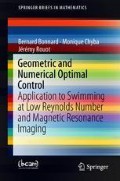Abstract
The two cases studied in this book show the practical interest of combining geometric optimal control with numeric computations using the developed software to solve industrial type problems.
You have full access to this open access chapter, Download chapter PDF
The two cases studied in this book show the practical interest of combining geometric optimal control with numeric computations using the developed software to solve industrial type problems.
The application to microswimmers is very recent and validate results obtained from fluid mechanics practitioners based on curvature control and Fourier analysis. The SR-geometry framework allows to compare different strokes and different swimmers, using the mechanical energy cost. The copepod mathematical swimmer is the simplest slender body model. Normal and abnormal strokes have interpretation in terms of sinusoidal and sequential paddlings. This leads to design a simple macroscopic copepod robot to validate the theoretical computations of the most efficient stroke. Another validation of the mathematical model using Resistive Force Theory for Stokes’ flow is coming from the observations [65] showing the agreement between observed and predicted displacements. The mathematical developments lead to solve the inverse problem of identifying the cost used for the copepod nauplii displacement.
The developments motivated by MRI are more profound and lead to intricate numerical investigations to deal with an highly complex optimal control problem with many local optimal solutions. Nevertheless we believe that the techniques validate by in vitro and in vivo experiments realized under the auspices of the ANR project DFG Explosy will find in a very near future applications in MRI diagnosis.
Author information
Authors and Affiliations
Corresponding author
Rights and permissions
Copyright information
© 2018 The Author(s), under exclusive license to Springer International Publishing AG, part of Springer Nature
About this chapter
Cite this chapter
Bonnard, B., Chyba, M., Rouot, J. (2018). Conclusion. In: Geometric and Numerical Optimal Control. SpringerBriefs in Mathematics. Springer, Cham. https://doi.org/10.1007/978-3-319-94791-4_4
Download citation
DOI: https://doi.org/10.1007/978-3-319-94791-4_4
Published:
Publisher Name: Springer, Cham
Print ISBN: 978-3-319-94790-7
Online ISBN: 978-3-319-94791-4
eBook Packages: Mathematics and StatisticsMathematics and Statistics (R0)

